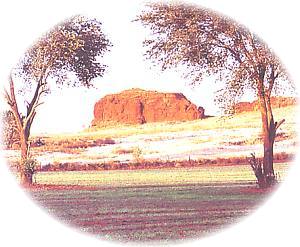Roger Mills County, OK
 Visitors are enticed with the vast beauty of the rolling red hills. Eons ago a vast inland sea covered this area iron deposts left behind gave our beautiful hills their rich, red color. Fossilized remains of prehistoric animals have been unearthed as have the stone tools and skeletal remains of the area?s first-known human inhabitants, the Mezo-Indians.
Visitors are enticed with the vast beauty of the rolling red hills. Eons ago a vast inland sea covered this area iron deposts left behind gave our beautiful hills their rich, red color. Fossilized remains of prehistoric animals have been unearthed as have the stone tools and skeletal remains of the area?s first-known human inhabitants, the Mezo-Indians. The distinctive formations of the Antelope Hills were a landmark for Spanish explorers in the 1500s and later for settlers moving west on the south branch of the California Road. The Comanches, Kiowas and Lipan Apaches dominated this part of the plains until the Cheyenne and Arapaho migrated here in the early 1800s.
Roger Mills County is named in honor of Roger Q. Mills, a Texas Congressman who supported Oklahoma for statehood. Before we were Roger Mills County, this area was known as "F" County, Oklahoma Territory, and Day County. The Land Run of 1892 opened the Cheyenne and Arapaho Reservation to white settlement. Many who live in the area are direct descendents of the pioneers and of Cheyenne Chief Black Kettle?s band.
Lt. Col. George Custer?s attack on Chief Black Kettle?s sleeping village in 1868 is commemorated in the Washita Battlefield National Historic Site, the Black Kettle Museum and the ?Washita Woman? Statue. Other
attractions such as the Strong City Townsite House, Santa Fe Depot,
Minnie R. Slief Community Museum, Metcalfe Art Gallery and Museum, and the Roll One-Room School depict the pioneer heritage and spirit that is a source of pride for residents of Roger Mills County.
Other landmarks include the Veteran?s Monument, Cheyenne Memorial Wall of Fame and Longhorn Field House. The Red Rock Records Vault is all that remains of the old courthouse burned by outlaws trying to destroy evidence against themselves.
Old west adventures become reality at the Black Kettle Roundup Club?s Memorial Rodeo on Memorial Day weekend as cowboys and cowgirls compete in the country?s top rodeo.
One of the oldest powwows in Oklahoma, the Red Moon PowWow takes place the last weekend in May with Native Americans in authentic clothing participating in song and dance contests.
The Pioneer Day Festival on the first Saturday after Labor Day features an arts & crafts show, games, exhibits, food, an auction and much more.
Explore Roger Mills County
Cheyenne Roger Mills Chamber of Commerce & Tourism
The Cheyenne Roger Mills Chamber of Commerce & Tourism is located in the old Black Kettle Museum. Stop in the visitor center and get directions and free brochures. You can purchase our Roger Mills County Afghans which come in 3
Cheyenne, OK BusinessesThe Augusta Metcalfe & Break O'Day Farm
Break O'Day Farm and Metcalfe Museum, the historic homestead and repository for the works of Oklahoma pioneer and “Sagebrush Artist,” Augusta Corson Metcalfe Directions:
Cheyenne, OK MuseumsCroton Creek Guest Ranch
This area is known for some of the best turkey and wild quail hunting in the country, however few know about the quality of our deer herd, which by the way is outstanding! Accommodations are comfortable and private in our “old western”
Cheyenne, OK HuntingRoll One-Room School
Step across the threshold of this restored one-room school and see the teacher and scholars in 1910 dress. Relive McGuffy Readers, ciphering, inkwells and pens, lunchtins, outhouses, marbles, roll the hoop, ante over, lye soap, and more in this "hands on" history experience.
Cheyenne, OK Pioneer HistoryAntelope Hills
The distinctive formations of the Antelope Hills were a landmark for Spanish explorers in the 1500
Cheyenne, OK LandmarksCheyenne City Park - Museums in the Park
The Cheyenne City Park contains seven museums, several memorial structures, playground equipment, a pavilion with a stage, a swimming pool, ball diamonds, handicap accessible bathrooms, and plenty of parking.
Cheyenne, OK MuseumsWashita Battlefield National Historic Site
Washita Battlefield National Historic Site protects and interprets the site of the Southern Cheyenne village of Peace Chief Black Kettle that was attacked by the 7th U.S. Cavalry under Lt. Col. George A. Custer just before dawn on November 27, 1868
Cheyenne, OK BattlesitesBlack Kettle National Grassland
Black Kettle National Grassland covers about 32,000 acres in western Oklahoma and 2,000 acres in Texas and is home to deer, turkey, and quail hunting.
Cheyenne, OK National GrasslandsThe Story of the Battle of the Washita
Introduction The cultural collision between pioneers and Indians reached its peak on the Great Plains during the decades before and after the Civil War. U.S. Government policy sought to separate tribes and settlers from each other by establishing an Indian Territory (present-day Oklahoma)
Cheyenne, OKVeterans' Monument
The Veterans' Monument is the largest monument west of the Mississippi with veteran's names of all wars and conflicts inscribed, and the only county memorial in the United States that lists all of its veterans. Outside viewing at any time, but come by during business hours to view the "Washita"
Cheyenne, OK MonumentsSanta Fe Depot
Cheyenne was the western terminus for the Clinton, Oklahoma, and Western Railroad (also known as the "COW") until the Santa Fe took over in 1928 and extended the line to Pampa, Texas. Passenger service survived until the 1960's using a "doodlebug" (AT&SF Motorcar #M.177) as train numbers 63 & 64
Cheyenne, OK Railroad HistoryHorseshoe Hills
This landmark is a unique formation of hills creating a natural horseshoe shape. Custer and his men camped there the night before the attack on Chief Black Kettle, serving as an ideal place to hide Custer'
Cheyenne, OK Landmarks